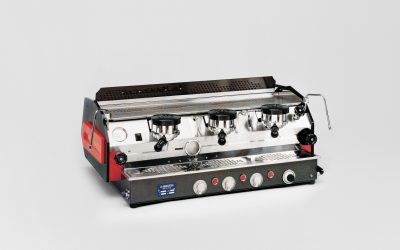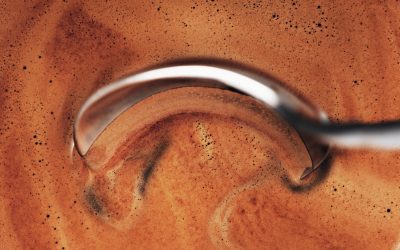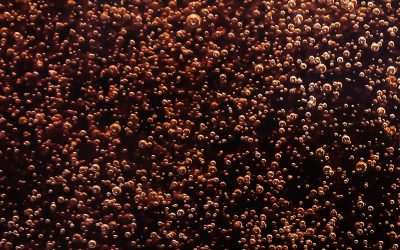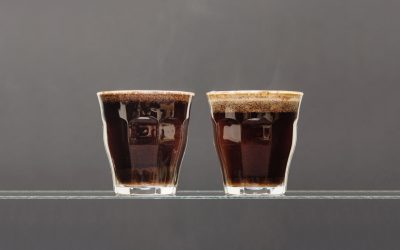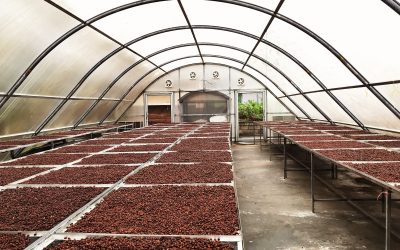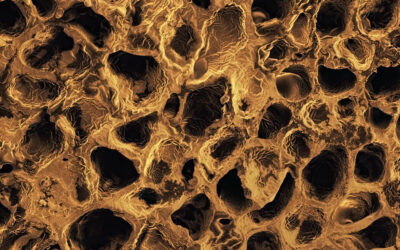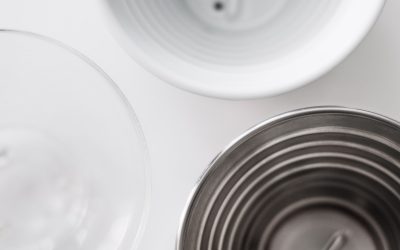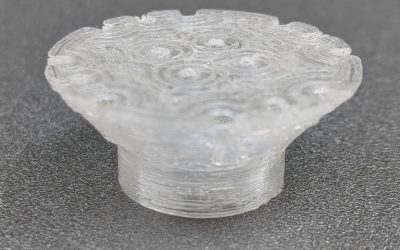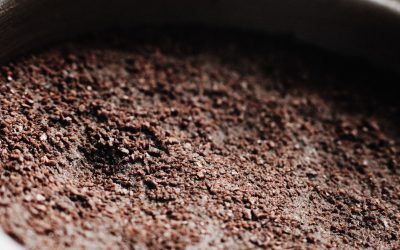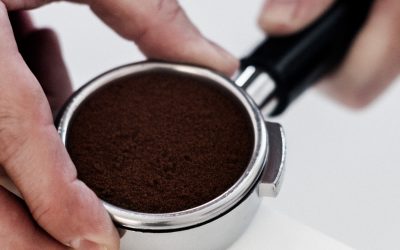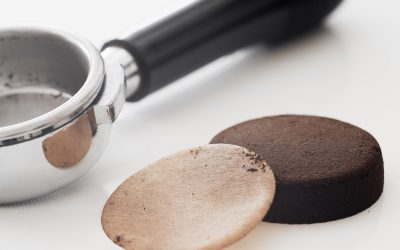Wheels of Steel
The coffee tasted vibrant and clean, and the salesperson showed me how easy it was to wipe away the residue from inside the portafilter — no more scrubbing away with a Scotch-Brite at the end of every day. The steel was a big selling point: easy to clean, more environmentally friendly …
Implementing a Life Cycle Analysis in Your Coffee Business
Now let’s look at how the app can inform your own life-cycle analysis. As we learned in Lesson 1.01, the first phase of an LCA is Goal Definition and Scope. The scope of the app is limited to the carbon …
Aroma and Aftertaste
Aftertaste, in coffee, refers to the tastes and aromas left in the mouth after swallowing. Compared to other drinks, coffee flavours hang around for a long time: the aftertaste of an espresso can last up to 15 minutes (RJ Clarke and OG Vitzthum, 2001). Depending on the coffee, this may or may not be a good thing.
Espresso Headspace
Received wisdom in coffee says that if you put a nickel, or a penny, on top of your puck after tamping, and lock the portafilter into the group and remove it again without brewing, you should just be able to see a slight impression in the puck from where the coin was pressed into the coffee.
The Coffee Footprint Analyzer
One of our aims in producing this course is to provide the information and tools you need to analyse your own carbon footprint. This will allow you to see which changes will have the biggest impact and help you determine which interventions will be most cost effective. At the core of this …
What is a Life-Cycle Analysis?
A defining characteristic of an LCA is that it includes the impact of raw materials, production, use, and disposal, simultaneously. For example, a change of material could reduce the CO2 footprint from the manufacturing stage, but result in higher maintenance requirements or shorten the lifespan …
A History of Greenwashing
I would like to start this course with a short story. A confession of sorts. Come with me, as I go to my local cafe. I have forgotten to bring my KeepCup again, but I see they use compostable takeaway cups, so I don’t feel so bad ordering my coffee. While I’m there, I pick up a box of beans …
Temperature’s Hidden Effect
In our most recent instalment of the Advanced Espresso course, we discussed a surprising finding in the scientific literature: that increasing the brew temperature makes espresso shots run more slowly. We set out to test this for ourselves, and discovered that the truth is more subtle …
Coffee Grinder RPM
In the last few years, a small number of grinders have hit the market that boast an adjustable grinding speed. The best known of these are Lynn Weber’s EG-1, Victoria Arduino’s Mythos 2, and most recently Ceado’s Hero E37Z. The marketing material for each of these grinders claims that being able …
Changing Grinder Burrs
If you’re looking at your grinder, asking yourself this question, then it’s probably time to change them. While grinder manufacturers may claim that their burrs can grind hundreds and sometimes thousands of kilos of coffee, the truth is that, after they are seasoned, burrs wear out gradually over time …
Cinnamongate
“It tastes exactly like a cinnamon bun. You have to try it.” Coffees often don’t entirely live up to their description, but this was different — a coffee with an instantly recognisable flavour of warm, sweet, cinnamon, like nothing I’d tasted before. I had joined the small crowd queuing up …
Why Do Espresso Shots Run Faster?
Why do espresso shots run faster when I use super fresh coffee? It is a truth universally acknowledged that the gases trapped in fresh coffee create bubbles in espresso, which slows down the flow and reduces extraction. This explains why shots from older coffee run...
What Can We Use to Remineralise Water for Coffee Brewing?
Apart from bicarb and epsom salts... A few months ago we released an updated version of our water recipes designed to allow you to easily target any hardness and alkalinity level you want, using two simple solutions — without having to do any complex maths. Since...
If a Coffee Doesn’t Form a Crust In a Cupping…
Does this mean it’s underdeveloped? Anyone who’s cupped very light roasted coffee, whether from a Nordic-style roaster, or perhaps from a sample roast, will have experienced this: it sometimes doesn’t form a crust in a cupping. When this happens on the cupping table,...
Sugars in Natural Processing
In natural processing, do sugars travel from the mucilage into the bean? Natural processed coffees are typically sweeter and more full-bodied than washed coffees, and often have distinctive fruity flavours. It seems intuitive that the sweetness, body, and...
Fluidised Beds
In our latest poll on the BH Facebook Group, you asked us to check this out: 'If flow goes in much faster than it comes out, then you have the potential to create a fluidised bed. Where does that leave espresso?' Here's what we found out ... This question follows on...
Steel, Glass, Ceramic?
What's the most temperature-stable material to use when brewing? The short answer is: plastic cones are best. They absorb heat from the brew water less quickly, absorb less heat overall, and lose that heat to the air more slowly. To really understand why plastic is...
What’s the Best Sprayhead Design?
Is it better to have as many holes as possible in your spray head, hardly any to make more agitation, or somewhere in between? To achieve even extraction in batch brewing, it’s important to get all the grounds evenly wetted — meaning exposed to the same amount of...
DIY Water Recipes Redux
A couple of years ago, we published a method for making your own water recipes, using concentrated mineral solutions, diluted with deionised water, to make a range of waters with different hardness and alkalinity. This post updates this, with new recipes that allow you to easily target a specific GH and KH in your water.
If Not Channelling, Then What?
"Professor Abbott told us he doesn’t really believe channelling occurs in espresso (except in drastic cases). So if not channelling, then what?" Only a few weeks ago we were telling you that over-extraction isn’t really a thing, and that it’s all caused by...
Fines Migration
You asked us to look into this topic, “In espresso, fines migration may not be as much of a thing as we thought.” Here’s what we found. Fines are the smallest particles created when you grind coffee. Depending on who you’re talking to, they might be defined as any...
Is It Better to Sieve Out Particles Smaller Than 400μm?
Espresso With Aeropress Filter Papers
Above and below the coffee bed This week, Scott Rao made espresso with filter papers above and below the coffee bed yielding over 25%. What's he playing at? If you follow Scott Rao’s series of daily coffee tips on Instagram, you’ll have seen one recent post where he...
What Difference Will It Make to an Espresso
Decades of trial and error have shown that most people prefer espresso extracted between 85-95°C (A Illy and R Viana, 1995). For lighter roasted, special coffee, the range typically used is rather narrower – 90-95°C. Within that small range though, there are still considerable variations in flavor to explore.
